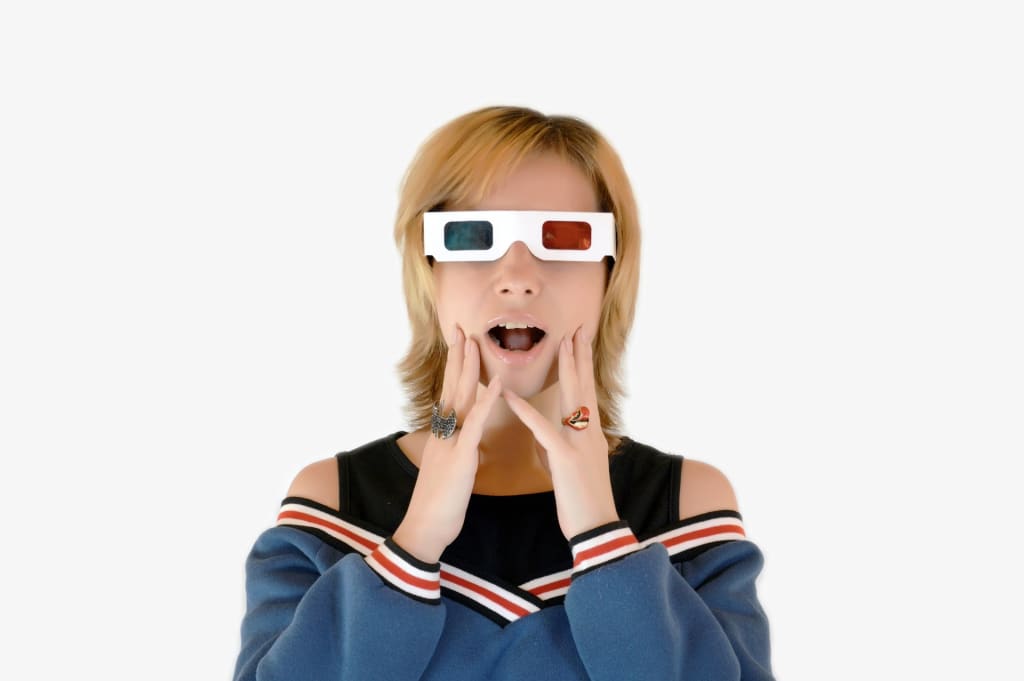The Magic of 3D Anaglyph Glasses: How They Work and What You Need to Know
Discover how the illusion of depth and dimension works. Take a look at the magic of 3D anaglyph glasses, and what you need to know for a mind-blowing viewing adventure.

Anaglyph glasses, or what most people call 3D glasses, have been around for generations. You may have worn a pair recently, but have you ever wondered how 3D glasses with colored lenses work? Or, what makes 3D anaglyph technology unique?
This article discusses how anaglyph glasses work, what makes 3D images unique, and what you should know about this fascinating technology.
Anaglyph Images and 3D Illusions
These 3D and anaglyph glasses simulate a three-dimensional object from a two-dimensional image. Let’s discuss how the brain processes visual information to understand how this works.
Our perception of distance and depth comes mainly from our eyes being spaced a short distance apart. Each eye sees the same view at a slightly different angle. This angular difference is called the parallactic angle.
Our brain combines the information it receives from both eyes so that there is no distortion in our vision. This process gives us binocular vision and the sensation of depth.
For an image to be perceived as three-dimensional, a different angle of the same scene must appear before each eye. This is how anaglyph images trick the brain.
Anaglyph 3D images are created using two photos of the same scene taken from different perspectives that match the parallactic angle. These images are printed on top of each other using chromatically opposite colors.
Chromatically opposite colors cancel each other out when mixed. Red and cyan are chromatically opposite colors, but other colors can work.
The 3D anaglyph lenses separate the images by blocking one color. Each eye sees a different view of the same image, with a small degree of angular difference that matches, more or less, the parallactic angle. The brain combines both views into a single image, creating a false three-dimensional sense.
Without appropriate 3D glasses, the unaided eye comprehends a confusing visual mess when looking at a typical colored 3D anaglyph image.

Different Types of 3D
Other technologies can be used to make and view 3D images. This includes polarized light, shuttered lenses, and stereoscopic photography.
Polarized Light 3D
Polarized 3D systems depend on polarized light.
Manufacturers of polarized 3D systems use different methods. They may use polarized light from a projector or polarized light reflected from an image. Headsets or glasses must be equipped with polarized lenses.
As far as the brain is concerned, these systems work the same way as colored-lens 3D systems. They deliver two images from different perspectives to each eye. This tricks the brain into perceiving a 3D image.
Since they depend on polarized light and not color, these systems need a projector or a display screen that polarizes light. The image can be viewed without polarized glasses but will not appear three-dimensional.
Shuttered 3D
Shuttered 3D uses active glasses with LCD lenses that work like a camera's shutter. They darken one lens at a time, blocking the image from reaching that eye. The screen or projector displays alternating views of the same scene from different perspectives, synchronized with the shutter.
This system requires constant communication with the projector to keep the glasses in sync with the media. Some flickering is noticeable.
Stereoscopic Cameras And Viewers
Stereoscopic cameras usually have two or more lenses arranged horizontally. In two-lens models, the lenses are typically spaced about 2.5 inches apart. Some stereoscopic cameras use a single lens and split the image internally.
A stereoscopic camera operates by simultaneously taking two pictures with a small degree of angular separation. When developed, the medium takes the form of two images placed side-by-side.

When viewed without a stereoscopic viewer, these images do not appear unusual aside from being two photos of the same thing. The stereoscopic viewer aids the illusion by limiting your field of view and focusing your eyes correctly on each image. This is enough to trick the brain into perceiving range and depth.
Things To Know
Enjoyment of 3D media and artwork may depend on the individual. Some people experience eye strain, for example, or headaches. Some users may experience mild symptoms of motion sickness.
3D Is Here To Stay
In the face of holography and other forms of advanced display technology that do not require wearing a special viewer, anaglyph 3D may seem quaint. While drawbacks may limit anaglyph 3D material to niche markets, it continues to pop up in the entertainment industry and elsewhere. Artists and technicians find new ways to use it every few years. And why not? It’s a unique medium that may offer untapped potential.
If you’re unfamiliar with 3D anaglyph media, maybe you should check it out. Viewing anaglyph 3D material can be a surprising and fun way to spend some leisure time.
About the Creator
William Powell
William Powell is a writer and educator with a passion for marketing. He enjoys learning about the latest business trends and analyzing how global events impact domestic and international economies.






Comments
There are no comments for this story
Be the first to respond and start the conversation.